Manuscript accepted on :
Published online on: 04-11-2021
Plagiarism Check: Yes
Reviewed by: Dr. Bhanu Lakhani

Second Review by: Dr. Asim Faraz

Final Approval by: I an james martin
Sachin Metkari1* , Dinesh Rao2
, Dinesh Rao2 and Kulvindersingh Banga1
and Kulvindersingh Banga1
1Conservative Dentistry and Endodontics, Nair Hospital Dental College, Mumbai Central, Mumbai-400008, Maharashtra, India. Maharashtra University of Health Sciences, Nashik (M.U.H.S., Nashik).
2Department of Pediatric Dentistry, Pacific Dental College and Hospital, PAHER University Udaipur-313001, Rajasthan, India.
Corresponding Author E-mail: drssmetkari@yahoo.co.in
DOI : https://dx.doi.org/10.13005/bpj/2315
Abstract
Background: Periapical extrusion of debris, irrigating solution and microorganism are the major contributing factors for flare-ups during root canal therapy. The aim of this ex vivo study was to evaluate the effect of different types of instrumentation in combination with different irrigation methods on apical bacterial expulsion. Material and Methods: Three hundred and ten extracted human permanent teeth were infected with Enterococcus faecalis. After incubation at 37°C for 24 h, three hundred teeth were instrumented with three different instrumentations using two irrigation methods. The remaining ten teeth were used as negative and positive control groups, in which no inoculation was done and no instrumentation was carried out respectively. Three hundred teeth were equally divided in three groups (n = 100), in which instrumentation was performed using a protaper universal rotary file (group 1), WaveOne reciprocating file (group 2) and a flexiCON rotary file (group 3). In each group, 50 samples were irrigated with conventional needle irrigation, and 50 samples were irrigated with the endoVac irrigation method. During instrumentation, apically extruded bacteria were collected in an Eppendorf tube. Microbiological samples were taken from the Eppendorf tube and incubated for 24h, and colony-forming units were counted. The data collected were statistically analysed. Results: The group 2 showed highest bacterial extrusion using conventional irrigation while group 3 showed lowest using endovac irrigation system. Conclusion: FlexiCON rotary instrumentation with the endoVac irrigation system produced significantly less bacterial extrusion than the other techniques.
Keywords
Bacterial Extrusion; Flare-Up; Irrigation
Download this article as:| Copy the following to cite this article: Metkari S, Rao D, Banga K. Effect of Different Instrumentation and Irrigation Methods on Apical Microbial Extrusion: An Ex Vivo Study. Biomed Pharmacol J 2021;14(4). |
| Copy the following to cite this URL: Metkari S, Rao D, Banga K. Effect of Different Instrumentation and Irrigation Methods on Apical Microbial Extrusion: An Ex Vivo Study. Biomed Pharmacol J 2021;14(4). Available from: https://bit.ly/3mIoVty |
Introduction
Chemo-mechanical preparation of the root canal system can result in periapical extrusion of pulpal remnant, dentinal shavings, necrotic tissues, irrigating solution and microorganisms, all of which can cause periapical inflammation and pain which may contribute to treatment failure 1,2. This periapical extrusion of bacteria and their by-products may result in cell-mediated or humoral immunological phenomena, causing pain, swelling or both, thereby resulting in flare-ups 3. When irrigating solutions, such as sodium hypochlorite, are forced out of the apex, they can cause severe inflammation, cellular destruction, haemolysis and tissue necrosis 4,5. During cleaning and shaping of the root canal system, any type of physical or chemical injury to the periradicular tissue can lead to degranulation of mast cells, with subsequent release of histamine into the periradicular tissue as a consequence 6. Therefore, periapical expulsion plays a major role in the outcome of endodontic therapy and should be reduced or eliminated. Although the quality (e.g. the virulence of the microbes) of extrusion cannot be controlled, the operator can reduce its quantity (e.g. the number of microbes) with proper instrumentation and irrigation methods.
Several features of contemporary endodontic practice, such as diagnosis, access preparation, cleaning and shaping, and obturation have evolved. Though various instrumentation systems are available to clean and shape the root canal system, they are unable to prevent the apical extrusion of debris, irrigant and microorganisms into the periradicular tissue 7-11. Although many studies have made reports on apical extrusion, no study has assessed periapical expulsion using a heat-treated nickel-titanium (Ni-Ti) flexiCON rotary file (Orbit Lifesciences Pvt. Ltd., Mumbai, India) with conventional or endoVac (Discus Dental, Culver City, CA, USA) irrigation methods and other combinations of instrumentation and irrigation methods.
Annealed Fire-Wire flexiCON Ni-Ti files (US Endodontics, Johnson City, TN, USA) are heat-treated files that were recently introduced and manufactured by US Endodontics (Johnson City, Tennessee, USA). The manufacturer claims that these files have incredible flexibility, improved cyclic fatigue resistance, no shape memory and no canal transportation 12,13. A reciprocating WaveOne system (Dentsply Maillefer, Ballaigues, Switzerland) is prepared with a special Ni-Ti alloy called M-Wire, which is created using an innovative thermal treatment process 14. The benefits of this M-Wire alloy include increased flexibility and improved resistance to cyclic fatigue 15,16. The advantages of the endoVac irrigation system include its ability to prevent apical extrusion by apical negative pressure and to deliver fresh irrigant to a working length safely. Thus the potential accidents due to positive pressure can be eliminated 17.
The study was carried out by comparing colony-forming units (CFUs) through the apical extrusion of Enterocuccous faecalis. The aim of the present study was to evaluate ProTaper Universal rotary (Dentsply Maillefer, Switzerland) with conventional needle/endoVac, WaveOne reciprocating with conventional needle/endoVac and flexiCON rotary with conventional needle/endoVac, irrigation and compare among the groups for apical bacterial extrusion.
Materials and methods
The study protocol was approved by institutional review board (No.: R/Pu/Ph.d/d/16/2840). Three hundred and ten extracted human single-rooted permanent teeth were selected for study analysis. The selected teeth were disinfected with 0.5% Sodium hypochlorite for 24 hours and then stored in physiological saline until used. All aseptic precautions were taken during the collection of the teeth, which adhered to the guidelines of the Occupational Safety and Health Administration. Single-rooted permanent teeth with mature apices and apical diameters that corresponded to an International Organisation of Standization (ISO) size no.15 k-file were included in this study. If ISO size no.15 k-file extruded beyond the apex of root by gentle filing, then such samples were excluded from study. All the teeth were evaluated under dental operating microscope (Karl Kaps, Germany) for cracks, caries and crown/root resorption, and if found were excluded from the study. To maintain uniformity among the samples, the lengths of all the selected teeth were standardized to 19 mm by reducing the tooth crown and conserving the coronal portion as a reservoir for irrigating solution. Working length of all teeth were standardized to 18 mm by subtracting 1 mm as apical constriction from total length (19mm). The presence of a patent single canal and apical curvature not more than 15° was confirmed using a digital radiography system (Clearray CMOS, Delhi, India) according to the method of Schneider’s principle [18]. The external surfaces of all the teeth were coated two to three times with nail varnish (Eyetex Dazller, Mumbai) to prevent irrigant solution and bacterial leakage.
In this ex-vivo study, protaper universal (PTU) rotary, waveOne (WO) reciprocating and flexiCON (FC) rotary systems were used for instrumentation of the canals using two different irrigation systems: conventional needle irrigation (CNI) and endoVac irrigation (EVI). EndoVac irrigation was done using macro cannula in the pulpal chamber and microcannula was placed within canal 3 mm short of apical constriction thereby producing apical negative pressure. A single operator with more than 10 years of experience in endodontics carried out all the endodontic procedures.
Experimental model
An Eppendorf tube (2 ml) suspended in a glass vial (50 ml) was used for collection of debris, irrigating solution and microorganisms (E. faecalis) expelled apically during instrumentation. Each tooth was suspended in the Eppendorf tube containing a rubber dam sheet punched in accordance with the tooth’s dimensions and cyanoacrylate gel to ensure a fluid-tight seal. Eppendorf tube was adjusted in the rubber stop of glass vial using hot instrument. The rubber dam sheet was used to cover the Eppendorf tube to blind the operator during canal instrumentation. Using a hot instrument, the Eppendorf tube was adjusted in the rubber stop of the glass vial. To balance internal and external pressures, a 26-guage needle (Unolok Syringe, Lur lok, Vin Pharma Agency, Mumbai, India) was inserted along the side of the mounted tooth into the Eppendorf tube through the rubber dam sheet, facilitating expulsion of apical debris, irrigating solution and E. faecalis. The entire model system was sterilized in an ethylene oxide gas sterilizer for a 15-h cycle at 72°C (Figure 1).
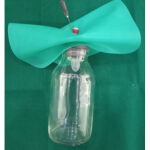 |
Figure 1: Experiment model |
Contamination with E. faecalis biofilm
E. faecalis (ATCC 29212 strain obtained from Dept. of Pathology RGMC Hospital Thane MS) was sub-cultured in brain-heart infusion broth to prepare a bacterial suspension and incubated at 37°C for 24 h. A volume of 1 ml of bacterial suspension (final concentration of about 1.5 ×108) was transferred to lumen of the root canal using a sterile high-precision micropipette (Sahakar Industrial Estate Thane, Maharashtra, India) (0.5–10 µl). The canals were hand instrumented using a 10 K-file to carry the bacteria down the length of canal. The access cavities were then sealed with Cavit™ temporary filling material (3M ESPE, Dental Products, USA). All samples were stored at 37°C for 10 d in a humid atmosphere, and re-inoculation was repeated every 72 h. The medium was replaced with fresh culture after 72 h and then every 1, 4, 7 and 10 d. After inoculation period, the teeth samples were rinsed with sterile saline and dried with paper points before instrumentation to ensure that the source of E. faecalis in the collected debris is not from the original broth filled in the root lumen during inoculation.
Evaluation of root canal bacteria
Before instrumentation, the samples were tested from each canal to detect biofilm formation. If the bacterial counts in the root canal were lower than 1.5 × 108 CFUs/ml, the tooth was discarded. These discarded samples were cultured again as described earlier until the bacterial count was ≥ 1.5 × 108 CFU/ml was attained.
Experimental groups and instrumentation procedures
Three hundred teeth were randomly divided into three groups (n = 100 in each group) using a simple random method, and five teeth in which no bacterial inoculation was done, considered as negative control and remaining five teeth were inoculated with bacteria but not instrumented, kept as positive control. Using aseptic techniques, one operator performed the canal preparation and sampling procedures on each specimen under a closed cabinet to prevent airborne bacterial contamination. All the instruments were used according to the manufacturer’s instructions. The flutes of the files were cleaned after every three to four in-and-out movements.
In each group, the samples were randomly divided into two subgroups (n = 50 in each) and irrigated with conventional irrigation or the endoVac irrigation method. Conventional irrigation was carried out using a 27-gauge double side-vented needle (RC Twents, prime dental products pvt. Ltd, Maharashtra, India). The needle was placed at the apical 3 mm level, and a pressure-less technique was used to deposit the solution. Frequent root canal irrigation was done using 10 ml of normal saline solution. EndoVac irrigation was carried out as per manufacturer’s instructions.
Instrumentation
Group 1: Protaper Universal rotary file instrumentation system
All the teeth in this group were instrumented using the protaper universal rotary instrumentation system. The protaper instruments Sx, S1, S2, F1, F2 were used in a crown-down manner according to the manufacturer’s instructions until a final apical size of 25.08 using gear reduction handpiece powered by a torque-controlled electric motor (X-Smart; Dentsply Maillefer, Japan).
Group 2: WaveOne reciprocating file instrumentation system
The teeth in this group were instrumented using the WaveOne reciprocating system. Instrumentation was carried out with primary single file, using a slow in-and-out pecking motion to ISO size 25.08, at 150°ccw/30°cw reciprocation according to the manufacturer’s instructions. WaveOne file instrumentation proceeded until no obstruction remained.
Group 3: FlexiCON file instrumentation system
All the teeth in this group were instrumented using flexiCON Ni-Ti X3 rotary instrumentation system, which includes negotiating files N1, N2, N3 and completing files C1, C2. Instrumentation was performed according to the sequence of the manufacturer’s instructions, until a final apical size 25.06.
Evaluation of apically extruded bacteria
After instrumentation, 1 ml of normal saline was added in each Eppendorf tube using a high precision micropipette. The tube was then vigorously shaken to ensure complete mixing of the extruded debris in the saline. Three hours after sedimentation of the debris, 10 µl of saline were cultured in brain heart infusion agar plates (HiMedia Laboratories, Pvt. Ltd., Mumbai, India) and kept in an incubator for 24 h. The CFU count of the bacteria was recorded as the number of CFUs/ml.
Statistical analysis
The statistical software IBM SPSS statistics 20.0 (IBM Corporation, Armonk, NY, USA) was used for the analyses of the data, and Microsoft Word and Excel were used to generate graphs, tables.
Descriptive and inferential statistical analyses were performed. The data was presented as mean ± SD. The level of significance was fixed at p = 0.05. Any value ≤ 0.05 was considered statistically significant.
The student’s t-test (two tailed, unpaired) was applied to detect difference between two groups. An analysis of variance (ANOVA) was used to determine the significance of the study parameters in the different groups. Further post hoc analysis was carried out if the values of the ANOVA test were significant.
Results and Discussion
No bacterial growth was observed in the negative control group (Figure 2) while there was more than 1.5x 108 cfu/mm bacterial growth observed in positive control group (Figure 3). All 300 samples showed bacterial growth after 24 h (Figure 4). CFU counts were compared within and between the groups. The highest CFU count was found in group 2 (WaveOne) using conventional irrigation (25.280 ± 3.2952), and the lowest CFU count was detected in group 3 (FlexiCON) using EndoVac irrigation (14.970 ± 3.2126). Within the groups, endoVac irrigation showed less CFU units than conventional needle irrigation irrespective of instrumentation methods used.
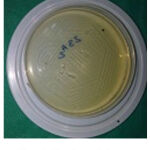 |
Figure 2: Negative control group |
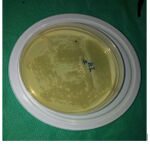 |
Figure 3: Positive control group |
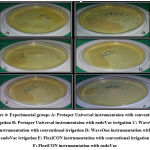 |
Figure 4: Experimental groups |
When the conventional irrigation method was used, there was a highly significant difference in bacterial growth in group 1 versus group 3 but no significant difference between group 2 and group 3. When the EndoVac irrigation method was applied, there was a highly significant difference in bacterial growth in group 1 versus group 2 and in group 1 versus group 3 (p ˂ 0.001) (Table 1,2,3) (Graph 1).
Table 1: Comparison of the colony forming units in terms of Mean (SD) for different file systems with different irrigations using unpaired t test
| Group | N | Mean | Std. Deviation | t value | P value | |
| Universal protaper | Conventional Irrigation | 50 | 24.610 | 3.9965 | 0.076 | 0.940 |
| EndoVac | 50 | 24.560 | 2.3940 | |||
| Wave one | Conventional Irrigation | 50 | 25.280 | 3.2953 | 5.134 | <0.001** |
| EndoVac | 50 | 21.610 | 3.8323 | |||
| Flexicon | Conventional Irrigation | 50 | 15.360 | 1.5651 | 0.772 | 0.442 |
| EndoVac | 50 | 14.970 | 3.2126 |
(p < 0.05 – Significant*, p < 0.001 – Highly significant**)
Table 2: Comparison of the colony forming units in terms of Mean (SD) for different file systems with conventional irrigation using ANOVA test
| Group | N | Mean | Std. Deviation | F value | P value |
| Universal protaper | 50 | 24.610 | 3.9965 | 157.458 | <0.001** |
| Wave one | 50 | 25.280 | 3.2953 | ||
| Flexicon | 50 | 15.360 | 1.5651 | ||
| Total | 150 | 21.750 | 5.5007 |
(p < 0.05 – Significant*, p < 0.001 – Highly significant**)
Table 3: Comparison of the colony forming units in terms of {Mean (SD)} for different file systems with EndoVac irrigation using ANOVA test
| Group | N | Mean | Std. Deviation | F value | P value |
| Universal protaper | 50 | 24.560 | 2.3940 | 117.737 | <0.001** |
| Wave one | 50 | 21.610 | 3.8323 | ||
| Flexicon | 50 | 14.970 | 3.2126 | ||
| Total | 150 | 20.380 | 5.1284 |
(p < 0.05 – Significant*, p < 0.001 – Highly significant**)
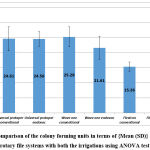 |
Graph 1: Comparison of the colony forming units in terms of {Mean (SD)} for different rotary file systems with both the irrigations using ANOVA test |
Discussion
Periapical extrusion is often associated with postoperative pain, swelling or flare-ups during or after root canal treatment. Such periapical expulsion depends upon instrumentation 19-21 (different file geometry, rotary or reciprocating movements) and irrigation of the root canal system 22-24 (type and method of delivery). The instrumentation systems used in the study were protaper universal rotary system, WaveOne reciprocating system and flexiCON rotary system in combination with conventional needle and endoVac irrigation methods. Irrigation of root canal system has vital role in debridement and disinfection, as it reaches inaccessible areas 25. Irrigants facilitates removal of tissue remnants, dentin chips and microorganism from the root canal systems through flushing action. Irrigants can also help prevent packing of hard and soft tissue in apical root canal and extrusion of infected debris into the periapical area. In addition, several irrigants have antimicrobial activity and actively kills bacteria and yeast when introduced in direct contact with microbes. However, several irrigants have cytotoxic potential and they can cause severe pain if they gain access to periapical tissues. So optimum use of root canal irrigant is crucial factor for successful treatment outcome. As the aim of the study was to quantify the extrusion of microbes, normal saline was used as the irrigating solution instead of sodium hypochlorite to prevent crystallization and disinfection. faecalis, a gram-positive facultative microorganism that is frequently found in unsuccessful root canal cases, was used to assess periapical expulsion in the present study. The experimental apparatus used in this study was similar to that used by Myers and Montgomery 26.
In the current study, apical bacterial extrusion was found in all experimental groups. Among the groups, using both the conventional needle and EndoVac irrigation methods, FlexiCON Ni-Ti rotary instrumentation was associated with the least bacterial extrusion. This outcome may be due to the superior flexibility, resistance to cyclic fatigue, no shape memory and no canal transportation of these heat-treated files as compared with the characteristics of the other file systems, thereby resulting in less aggressive cutting efficiency and less debris expulsion. This observation is in agreement with that of Kumar et al. 27, who concluded that the FlexiCON X7 produced the least apical debris, whereas protaper next files produced the most.
The results of the present study are in accordance with the observations of Bruklein and Shafer 28, who reported that full-sequence rotary instrumentation (Mtwo and Protaper) was associated with less debris extrusion as compared with that of reciprocating single-file systems (WaveOne and Reciproc). They attributed this finding to the significantly speedier preparation with reciprocal files as compared with the preparation times using other files, concluding that the latter may lead to more debris extrusion 29. The findings are also consistent with those Surakanti et al 30. in studies of Protaper, Hyflex, (full-sequence) and WaveOne reciprocating systems. The amount of debris extrusion may also be explained by the number of files, with a greater file number associated with more debris and more bacteria exiting coronally. Reciprocation systems have a larger cutting angle and smaller releasing angle and flute than full-sequence files therefore, they push debris into the apical area, as reported in an earlier study 28.
In the present study, the WaveOne reciprocating instrumentation in combination with endoVac irrigation caused less extrusion than the protaper universal multi-file rotary system. This finding correlates with that reported in other studies 31-34 which attributed to differences in the experiment set-up, study design and type of teeth used, in addition to the instrument design, file type, number of flutes, cutting efficiency, cutting edge and cross sections of the files.
An additional finding of the current study was reduced periapical expulsion using the endoVac irrigation method as compared with conventional needle irrigation. This finding is in agreement with that of various other studies 22,35,36. One systematic review reported that apical negative pressure prevented apical extrusion of debris and irrigating solution when compared with conventional needle irrigation 37. This finding was supported by several other studies, although the results were not statistically significant 38-41.
In the present study, the flexiCON system with endoVac irrigation was associated with minimal periapical expulsion. Previous research demonstrated that these heat-treated Ni-Ti files exhibited enhanced resistance to cyclic fatigue and that their remarkable flexibility resulted in less aggressive cutting efficiency 42. FlexiCON files also showed no shape memory and no canal transportation. This could lead to less debris formation. Hence, annealed heat-treated Ni-Ti files produced less periapical expulsion. More studies are required for validation of the clinical implications.
Conclusion
All the instrumentation systems resulted in bacterial extrusion. The flexiCON rotary system with the endoVac irrigation method produced significantly less bacterial extrusion as compared other groups. WaveOne reciprocating system using conventional needle irrigation showed highest bacterial extrusion. In all the instrumentation groups, the endoVac irrigation method was associated with less bacterial extrusion than the conventional needle irrigation method.
Acknowledgement
We were very grateful for help and support of Dr. Milind Ubale, Proff and Head, Dept.,of Microbiology and Mr.Sandeep Gungambhire for the study.
Conflict of interest
No conflict of interest.
Funding source
This study was self-funded.
References
- Kherlakian D, Cunha RS, Ehrhardt IC, Zuolo ML, Kishen A, da Silveira Bueno CE. Comparison of the incidence of postoperative pain after using 2 reciprocating systems and a continuous rotary system: A prospective randomized clinical trial. J Endod 2016; 42:2:171-6.
CrossRef - Nivethithan T, Raj JD. Endodontic pain-cause and management: A review. Int J Pharm Sci Res 2015; 6(7): 2723-7.
- Siqueira JF Jr. Microbial causes of endodontic flare‑ups. Int Endod J 2003; 36:453-63.
CrossRef - Bosch-Aranda ML, Canalda-Sahli C, Figueiredo R, Gay-Escoda C. Complications following an accidental sodium hypochlorite extrusion: A report of two cases. J Clin Exp Dent. 2012;4(3): e194-e198.
CrossRef - Mehdipour O, Kleier DJ, Averbach RE. Anatomy of sodium hypochlorite accidents. Compend Contin Educ Dent 2007; 28:544–50.
- Siqueria JF, Jr, Barnett F. Interappointment pain: Mechanisms, diagnosis, and treatment. Endod Topics. 2004;7: 93–109.
CrossRef - Al-Omari MAO, Dummer PMH Canal blockage and debris extrusion with eight preparation techniques. J Endod 1995;21(3):154-158.
CrossRef - Reddy SA, Hicks ML. Apical extrusion of debris using two hand and two rotary instrumentation techniques. J Endod 1998; 24 :180-183.
CrossRef - Azar NG, Ebrahimi G. Apically-extruded debris using the protaper system. Aust Endod J 2005;31(1):21-23.
CrossRef - Er, K., Z. Sümer, and K. E. Akpınar. Apical extrusion of intracanal bacteria following use of two engine‐driven instrumentation techniques. Int Endod J12 (2005): 871-876.
CrossRef - Garlapati R, Venigalla BS, Patil JD, Raju RV, Rammohan C. Quantitative evaluation of apical extrusion of intracanal bacteria using K3, Mtwo, RaCe and protaper rotary systems: An in vitro study. J Conserv Dent. 2013 Jul 1;16(4):300-303.
CrossRef - http://www.flexicon.in/pdf/X7-Hyflex-K3-AND-M2-Series.pdf dated 1/03/2019.
- https://www.dentbay.com/flexicon-x5-niti-rotary-files.html dated 1/03/2019.
- Gutmann JL, Gao Y. Alteration in the inherent metallic and surface properties of nickel-titanium root canal instruments to enhance performance, durability and safety: a focused review. Int Endod J 2012; 45:113–28.
CrossRef - Al-Hadlaq SM, Aljarbou FA, AlThumairy RI. Evaluation of cyclic flexural fatigue of Mwire nickel-titanium rotary instruments. J Endod 2010; 36:305–307.
CrossRef - Alapati SB, Brantley WA, Iijima M, Metallurgical characterization of a new nickel-titanium wire for rotary endodontic instruments. J Endod 2009; 35:1589–1593.
CrossRef - Mitchell RP, Yang SE, Baumgarter JC. Comparison of apical extrusion of NaOCl using the EndoVac or needle irrigation of root canal. J Endod 2010:36(2):338-341.
CrossRef - Schneider SW. A comparison of canal preparations in straight and curved root canals. Oral Surg Oral Med Oral Path Oral Rad and Endod 1971;2: 271–275.
CrossRef - Ferraz CCR, Gomes NV, Gomes BPFA, Zaia AA, Teixeira FB and Souza-Filho FJ. Apical extrusion of debris and irrigants using two hand and three engine-driven instrumentation techniques. Int Endod J 2001; 34(5):354-358.
CrossRef - Tinaz AC, Alacam T, Uzun O, Maden M and Kayaoglu G. The effect of disruption of apical constriction on periapical extrusion. J Endod 2005;31(7):533-5.
CrossRef - Kustarci A, Altunbas D and Akpinar KE. Comparative study of apically extruded debris using one manual and two rotary instrumentation techniques for endodontic retreatment. J DENT SCI 2012; 7(1):1-6.
CrossRef - İriboz, E., Bayraktar, K., Türkaydın, D. and Tarçın, B. Comparison of apical extrusion of sodium hypochlorite using 4 different root canal irrigation techniques.J Endod 2015 ;41(3):380-4.
CrossRef - Yost, R.A., Bergeron, B.E., Kirkpatrick, T.C., Roberts, M.D., Roberts, H.W., Himel, V.T. and Sabey, K.A. Evaluation of 4 different irrigating systems for apical extrusion of sodium hypochlorite. J Endod 2015;41(9):1530-4.
CrossRef - Barbosa-Ribeiro M, Arruda-Vasconcelos R, Fabretti FL, Silva EJNL, De-Deus G, Gomes BPFA. Evaluation of Apically Extruded Debris Using Positive and Negative Pressure Irrigation Systems in Association with Different Irrigants. Braz Dent J 2018;29(2): 184-188.
CrossRef - Peters OA, Scho¨nenberger K, Laib A. Effects of four Ni-Ti preparation techniques on root canal geometry assessed by micro computed tomography. Int Endod J 2001;34:221–30.
CrossRef - Myers GL, Montgomery S. A comparison of weights of debris extruded apically by conventional filing and Canal Master techniques. J Endod 1991; 17:275-9.
CrossRef - Kumar GP, Godavarthy DS, Yarlagadda M, Beesetty N, Killi N. Apical extrusion of debris in mesiobuccal root of maxillary molars with five rotary file systems. J Clin and Diagno Res. 2018:05 ZC05 – ZC09.
CrossRef - Burklein S and Scahfer E. Apically extruded debris with reciprocating single-file and full-sequence rotary instrumentation systems. J Endod 2012;38(6):850-2.
CrossRef - Saberi E, ZahedaniSS, Ebrahimipour Apical extrusion of intracanal bacteria with single file and multifile rotary instrumentation systems. J Int Soc of Prevent Communit Dent 2017; 7(5):292-6.
CrossRef - Surakanti JR, Venkata RP, Vemisetty HK, Dandulo RK, Jaya NM, Thota S (2014) comparative evaluation of apically extruded debris during root canal preparation using ProtaperTM, HyflexTM and WaveoneTM rotary system. J Conserve Dent 2014:17(2):129-32.
CrossRef - Tinoco JM, De‐Deus G, Tinoco EM, Saavedra F, Fidel RA, Sassone LM. Apical extrusion of bacteria when using reciprocating single‐file and rotary multifile instrumentation systems. Int Endod J 2014 :1;47(6):560-6.
CrossRef - KÜÇÜKYILMAZ Ebru, SAVAS Selcuk, SAYGILI Gokhan, UYSAL Banu. Assessment of apically extruded debris and irrigant produced by different nickel-titanium instrument systems. Braz Oral Res 2015; 29(1): 1-6.
CrossRef - De-Deus G, Neves A, Silva EJ, Mendonça TA, Lourenço C, Calixto C, et al.Apically extruded dentin debris by reciprocating single-file and multi-file rotary system. Clin Oral Investig 2015; 19:357-61.
CrossRef - Ustun Y, Canakci BC, Dincer AN, Er O and Duzgun S. Evualation of apically extruded debris associated with several Ni-Ti system. Int Endod J 2015;48(7):701-4.
CrossRef - Yost, R.A., Bergeron, B.E., Kirkpatrick, T.C., Roberts, M.D., Roberts, H.W., Himel, V.T. and Sabey, K.A. Evaluation of 4 different irrigating systems for apical extrusion of sodium hypochlorite.J Endod 2015 ;41(9):1530-4.
CrossRef - Barbosa-Ribeiro M, Arruda-Vasconcelos R, Fabretti FL, Silva EJNL, De-Deus G, Gomes BPFA. Evaluation of Apically Extruded Debris Using Positive and Negative Pressure Irrigation Systems in Association with Different Irrigants. Braz Dent J 2018; 29(2): 184-8.
CrossRef - Romualdo PC, de Oliveira KM, Nemezio MA, Küchler EC, Silva RA, Nelson-Filho P, Silva LA. Does apical negative pressure prevent the apical extrusion of debris and irrigant compared with conventional irrigation? A systematic review and meta-analysis. Aust Endod J 2017; 43: 129–37.
CrossRef - Nielsen BA, Baumgartner JC. Comparison of the EndoVac system to needle irrigation of root canals. J Endod 2007; 33:611–5.
CrossRef - Kungwani ML, Prasad KP, Khiyani TS. Comparison of the cleaning efficacy of EndoVac with conventional irrigation needles in debris removal from root canal. An in-vivo study. J Conserv Dent. 2014; 17(4): 374–8.
CrossRef - Saini M, Kumari M, Taneja S. Comparative evaluation of the efficacy of three different irrigation devices in removal of debris from root canal at two different levels: An in vitro study. J Conserv Dent2013 ;16(6):509-513.
CrossRef - Brito PR, Souza LC, Machado de Oliveira JC. Comparison of the effectiveness of three irrigation techniques in reducing intracanal Enterococcus faecalis populations: an in vitro study. J Endod 2009; 35:1422–7.
CrossRef - Chi CW, Lai EHH , Liu CY, Lin CP, Shin CS.Influence of heat treatment on cyclic fatigue and cutting efficiency of ProTaper Universal F2 instruments. J Dent Sci 2017;12: 21-6.
CrossRef







